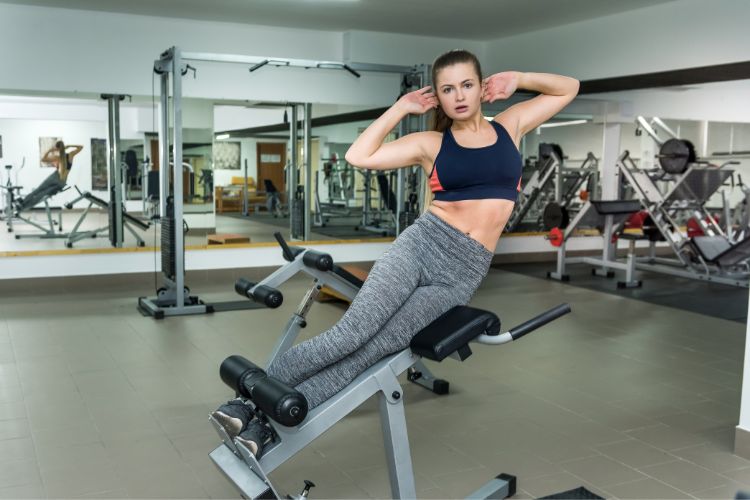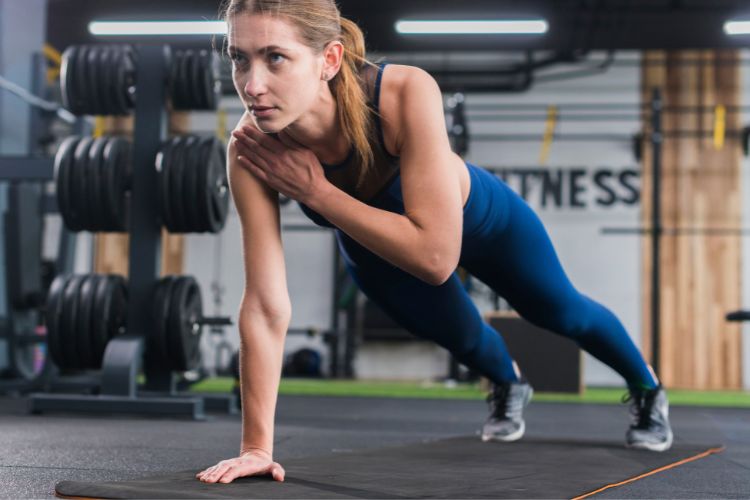Sign up for workout ideas, training advice, reviews of the latest gear and more.






Crunches have been synonymous with abdominal workouts for decades. They’re a staple exercise that many women turn to when aiming for that sculpted midsection. Whether you’re a fitness novice or a seasoned gym enthusiast, understanding the benefits, types, and techniques of crunch exercises can help maximize their impact.
Targeted Abdominal Strength: Crunches primarily work the rectus abdominis muscle, which is the front sheath of your abdominal muscles. Regular crunches can help tone and strengthen this muscle group.
Improved Posture: Strengthening your core through crunch exercises can aid in maintaining an upright posture. This is particularly beneficial for women who spend a lot of time at desks or those prone to back pain.
Flexibility: Crunches improve the flexibility of your core muscles, making daily activities and other exercises easier and safer.
Traditional Crunch: Lying flat on your back with knees bent and feet flat on the ground, lift your upper body using your abdominal muscles, ensuring your lower back remains on the floor.
Reverse Crunch: Instead of lifting your upper body, you lift your legs. This exercise focuses more on the lower abs.
Oblique Crunches: These target the side abdominal muscles. Lay on your back, but twist your torso as you come up, aiming to touch your right elbow to your left knee and vice versa.
Bicycle Crunches: A dynamic movement, this exercise involves bringing opposite elbow to opposite knee in a pedaling motion while lying on your back.
Stability Ball Crunches: Using a stability ball to support your lower back, this variation can reduce strain on the back while intensifying the crunch.
Maintain Proper Form: The most common mistake is pulling the neck forward, straining it. Instead, keep your hands lightly behind your head and use your core to lift.
Breathing: Exhale as you lift your body and inhale as you return to the starting position. Proper breathing can increase the effectiveness of the exercise.
Range of Motion: Focus on the quality of each crunch rather than the quantity. It’s not about how high you can lift but rather the contraction of the muscles.
Engage the Core: Ensure you’re really using your abdominal muscles to lift, rather than relying on momentum.
Start Small: If you’re new to crunches or it’s been a while, start with a set of 10 to 15 repetitions. As you build strength, you can increase the reps and sets.
Mix It Up: To avoid hitting a plateau, incorporate various types of crunches into your workout.
Combine with Cardio: For optimal fat burning and to unveil those toned abs, combine your crunch routine with cardiovascular exercises like jogging, cycling, or aerobics.
Not a Solo Solution: While crunches are effective for strengthening and toning, they won’t “spot reduce” belly fat. A combination of cardio, strength training, and a balanced diet is essential.
Listen to Your Body: If you feel any unusual pain, especially in the neck or lower back, reevaluate your form or consider taking a break. As always, it’s a good idea to consult with a fitness professional to ensure you’re doing exercises correctly.
Pregnancy and Postpartum: Pregnant women and those in the postpartum phase should approach crunches with caution. During pregnancy, some women develop diastasis recti (a separation of the abdominal muscles). Crunches can exacerbate this condition. It’s essential to consult with a healthcare professional before diving into any abdominal exercises during this time.
While the fundamentals of crunch exercises provide a robust foundation, delving deeper can further amplify results and maintain engagement. Let’s explore advanced variations, common myths, and how to prevent injuries.
Pilates Crunches: Incorporate a pilates ring or magic circle between your legs to engage not just the core but also the inner thighs. Squeeze the ring as you crunch upward.
Dead Bug Crunch: While lying on your back, raise your legs and arms to the sky. Lower one arm behind your head and the opposite leg simultaneously, contracting the abs and ensuring your lower back stays glued to the floor.
V-Crunch or Boat Crunch: Sitting on a mat, lean back and lift both legs up, forming a ‘V’ with your body. Extend your arms forward for balance. This exercise engages both the upper and lower abs.
Plank to Crunch: Begin in a plank position. Bring one knee forward towards the opposite elbow, return to plank, and repeat on the other side. This dynamic movement enhances core strength and stability.
Myth 1: Crunches Alone Will Give You a Six-Pack: As mentioned earlier, while crunches are a potent tool for core strengthening, they cannot single-handedly burn the belly fat that often covers abdominal muscles. This requires a comprehensive approach involving nutrition and other forms of exercise.
Myth 2: Daily Crunches are a Must: Just like any other muscle, your abs need rest to recover and grow. Overworking them with daily crunches can lead to strain and limit muscle development. Aim for 2-4 ab-focused sessions per week.
Myth 3: More Reps Equals Better Results: Quality over quantity remains the golden rule. It’s better to perform 20 well-executed crunches than rush through 50 with poor form.
Mind the Neck: Keep a fist-sized space between your chin and chest to prevent neck strain. Imagine an orange tucked under your chin – this will help maintain the right posture.
Flat Back: Pressing your lower back into the ground will engage the core muscles more effectively and reduce the risk of back injury.
Foot Placement: Your feet should be flat on the ground, hip-width apart. This positioning provides stability and ensures you’re not using your legs to propel the movement.
Slow and Steady: Rapid movements can not only reduce the effectiveness of the exercise but also increase the risk of injury. A controlled, deliberate crunch is the way to go.
Boosted Confidence: Every time you complete a set, you’re not just building stronger abs but also bolstering your self-confidence. The dedication and discipline required can make you feel accomplished.
Stress Relief: Exercise, including crunches, triggers the release of endorphins – the body’s natural mood elevators. It can be a great way to channel stress or negative energy.
Mind-Muscle Connection: As you focus on engaging your core, you foster a strong mind-muscle connection, enhancing not just the effectiveness of the exercise but also your overall mindfulness.
Crunch exercises, while seemingly straightforward, offer a vast playground for women seeking core strength and toning. By delving into its deeper layers, understanding myths, practicing injury prevention, and exploring advanced variations, you’re setting the stage for a holistic fitness journey. The beauty of crunches lies in their adaptability – they can evolve with you, matching each stage of your fitness journey. Embrace their full spectrum, and your core will undoubtedly thank you.
Stay up to date on the latest women’s health, fitness and lifestyle trends and tips.